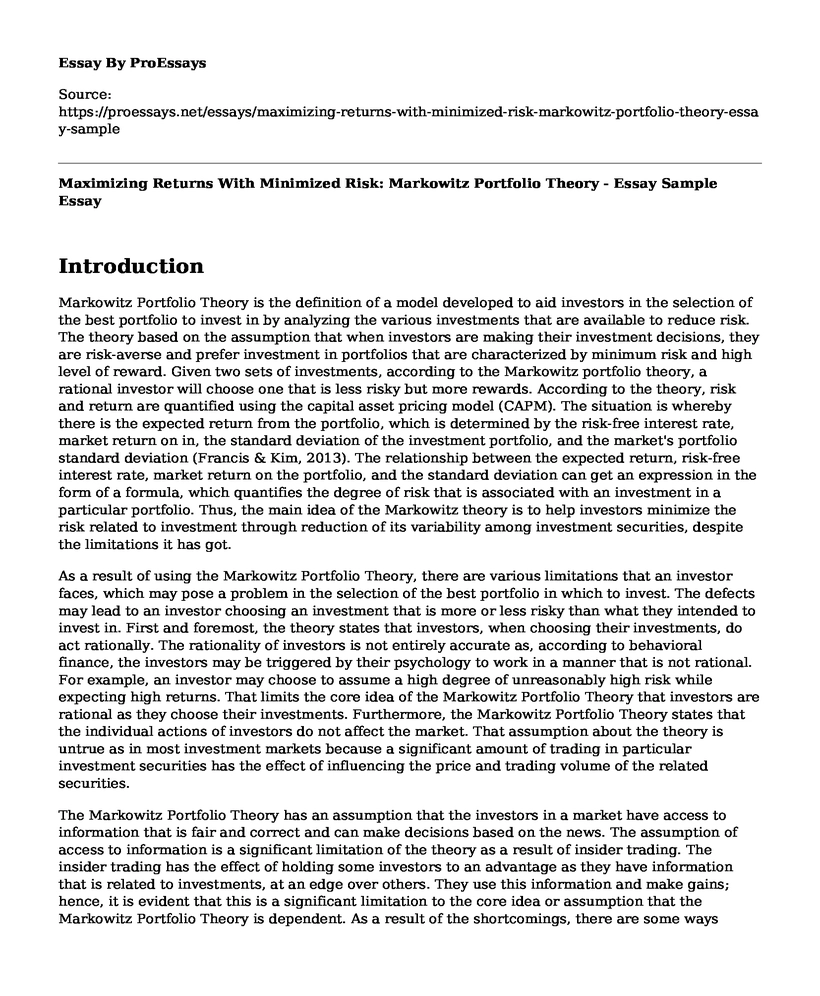Introduction
Markowitz Portfolio Theory is the definition of a model developed to aid investors in the selection of the best portfolio to invest in by analyzing the various investments that are available to reduce risk. The theory based on the assumption that when investors are making their investment decisions, they are risk-averse and prefer investment in portfolios that are characterized by minimum risk and high level of reward. Given two sets of investments, according to the Markowitz portfolio theory, a rational investor will choose one that is less risky but more rewards. According to the theory, risk and return are quantified using the capital asset pricing model (CAPM). The situation is whereby there is the expected return from the portfolio, which is determined by the risk-free interest rate, market return on in, the standard deviation of the investment portfolio, and the market's portfolio standard deviation (Francis & Kim, 2013). The relationship between the expected return, risk-free interest rate, market return on the portfolio, and the standard deviation can get an expression in the form of a formula, which quantifies the degree of risk that is associated with an investment in a particular portfolio. Thus, the main idea of the Markowitz theory is to help investors minimize the risk related to investment through reduction of its variability among investment securities, despite the limitations it has got.
As a result of using the Markowitz Portfolio Theory, there are various limitations that an investor faces, which may pose a problem in the selection of the best portfolio in which to invest. The defects may lead to an investor choosing an investment that is more or less risky than what they intended to invest in. First and foremost, the theory states that investors, when choosing their investments, do act rationally. The rationality of investors is not entirely accurate as, according to behavioral finance, the investors may be triggered by their psychology to work in a manner that is not rational. For example, an investor may choose to assume a high degree of unreasonably high risk while expecting high returns. That limits the core idea of the Markowitz Portfolio Theory that investors are rational as they choose their investments. Furthermore, the Markowitz Portfolio Theory states that the individual actions of investors do not affect the market. That assumption about the theory is untrue as in most investment markets because a significant amount of trading in particular investment securities has the effect of influencing the price and trading volume of the related securities.
The Markowitz Portfolio Theory has an assumption that the investors in a market have access to information that is fair and correct and can make decisions based on the news. The assumption of access to information is a significant limitation of the theory as a result of insider trading. The insider trading has the effect of holding some investors to an advantage as they have information that is related to investments, at an edge over others. They use this information and make gains; hence, it is evident that this is a significant limitation to the core idea or assumption that the Markowitz Portfolio Theory is dependent. As a result of the shortcomings, there are some ways through which the defects can get eliminated (Constantinides & Malliaris, 1995). First is through strict regulations concerning the sharing of insider information, whereby there is the punishment of the investors that benefit from the use of insider information. Furthermore, dealing with limitations of trading related to behavioral finance can be of help; for example, avoiding hindsight bias, confirmation bias, and overconfidence. If an investor can avoid the various forms of behavioral finance when making their investment decisions, then they will be in a better position to limiting the provisions of the Markowitz Portfolio Theory framew
References
Francis, J. C., & Kim, D. (2013). Modern portfolio theory: Foundations, analysis, and new developments (Vol. 795). John Wiley & Sons.
Constantinides, G. M., & Malliaris, A. G. (1995). Portfolio theory. Handbooks in operations research and management science, 9, 1-30.
Cite this page
Maximizing Returns With Minimized Risk: Markowitz Portfolio Theory - Essay Sample. (2023, Mar 22). Retrieved from https://proessays.net/essays/maximizing-returns-with-minimized-risk-markowitz-portfolio-theory-essay-sample
If you are the original author of this essay and no longer wish to have it published on the ProEssays website, please click below to request its removal:
- Investment Entry Mode - Essay Example
- Deductions and Losses: Certain Itemized Deductions
- World Bank and IMF in Vietnam Essay
- Stock Market Investment Fantasy League Project Paper Example
- Research Paper on Taxation: The Unavoidable Levy of Governments
- Paper Example on The Healthcare Debate
- Individual Income Tax - Report Example







